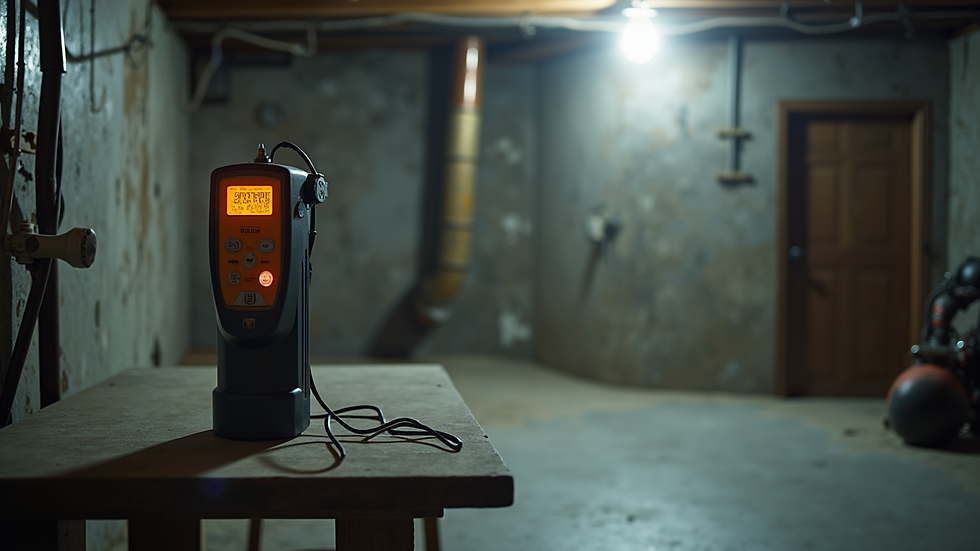Protect Your Home with Accurate Radon Testing
- Frank Talarico
- Aug 31
- 4 min read
Radon is a silent threat that can invade your home without any warning. This naturally occurring radioactive gas is colorless, odorless, and tasteless, making it impossible to detect without proper testing. Protecting your family and your home starts with understanding radon and ensuring accurate home radon checks are performed regularly. This article will guide you through the importance of radon testing, how to conduct effective home radon checks, and what to do if elevated radon levels are found.
Why Home Radon Checks Are Essential
Radon gas forms from the natural breakdown of uranium in soil, rock, and water. It can seep into homes through cracks in floors, walls, and foundations. Because radon is invisible and undetectable by human senses, many homeowners remain unaware of its presence. However, prolonged exposure to high radon levels can lead to serious health risks, including lung cancer.
Key reasons to prioritize home radon checks:
Health Protection: Radon is the second leading cause of lung cancer after smoking. Testing helps identify if your home has dangerous radon levels.
Peace of Mind: Knowing your home’s radon levels allows you to take action or rest assured that your environment is safe.
Real Estate Transactions: Many states require radon testing during home sales to protect buyers.
Cost-Effective Prevention: Early detection can save you money by preventing costly health issues and expensive mitigation later.
Regular home radon checks are a simple step that can make a significant difference in your family’s health and safety.

Radon detectors are essential tools for accurate home radon checks.
How to Perform Effective Home Radon Checks
Performing home radon checks involves using specialized devices that measure radon levels over a period of time. There are two main types of radon tests: short-term and long-term.
Short-Term Tests
Duration: 2 to 7 days
Use: Quick screening to determine if radon levels are elevated
Devices: Charcoal canisters, electret ion chambers, or continuous radon monitors
Placement: In the lowest lived-in level of the home, away from drafts, high humidity, and direct sunlight
Long-Term Tests
Duration: 90 days to 1 year
Use: Provides a more accurate average radon level over time
Devices: Alpha track detectors or electret ion chambers
Placement: Same as short-term tests, but left undisturbed for the entire testing period
Steps for Accurate Testing
Choose the Right Test: Decide between short-term or long-term based on your needs.
Prepare Your Home: Close windows and doors except for normal entry and exit during the test.
Place the Detector Properly: Follow manufacturer instructions carefully.
Avoid Disturbing the Device: Keep the testing area free from movement or interference.
Send the Device for Analysis: If using a mail-in test, send it promptly after the testing period.
Interpret Results: Radon levels are measured in picocuries per liter (pCi/L). The EPA recommends action if levels exceed 4.0 pCi/L.
For professional assistance, consider contacting radon testing services to ensure precise and reliable results.

Basements are common areas where radon testing devices are placed for accurate readings.
What Are the Symptoms of Radon in Your House?
Unlike many household hazards, radon exposure does not produce immediate or obvious symptoms. This makes it especially dangerous because you cannot rely on physical signs to detect its presence. However, long-term exposure to high radon levels can lead to serious health issues, primarily lung cancer.
Health Effects of Radon Exposure
Lung Cancer Risk: Radon is the second leading cause of lung cancer in the United States. Smokers exposed to radon have an even higher risk.
No Immediate Symptoms: Radon exposure does not cause symptoms like headaches, dizziness, or respiratory issues in the short term.
Delayed Onset: Lung cancer caused by radon exposure may take years or decades to develop.
Because there are no direct symptoms of radon exposure, the only way to protect your family is through regular and accurate home radon checks.

Radon test kits should be placed in commonly used living areas for effective monitoring.
Steps to Take If Your Home Has High Radon Levels
If your radon test results show levels above the EPA action level of 4.0 pCi/L, it is important to act quickly to reduce radon concentrations in your home.
Mitigation Options
Sub-Slab Depressurization: The most common and effective method. A vent pipe system and fan are installed to draw radon from beneath the house and release it outside.
Sealing Cracks and Openings: While not a standalone solution, sealing entry points can reduce radon infiltration.
Improving Ventilation: Increasing air circulation in the home can help lower radon levels.
Crawl Space Ventilation: For homes with crawl spaces, improving ventilation or installing a vapor barrier can reduce radon.
Hiring a Professional
Radon mitigation requires expertise to ensure the system is effective and safe. Hiring certified radon mitigation professionals is recommended to:
Assess your home’s radon entry points
Design a customized mitigation system
Install and test the system for effectiveness
Follow-Up Testing
After mitigation, conduct follow-up home radon checks to confirm that radon levels have been reduced to safe levels.
Maintaining a Radon-Safe Home
Protecting your home from radon is an ongoing process. Here are some practical tips to maintain a radon-safe environment:
Test Every 2 Years: Radon levels can fluctuate due to changes in weather, home renovations, or soil conditions.
Test After Renovations: Any changes to your home’s foundation or ventilation can affect radon levels.
Keep Your Mitigation System Running: If you have a radon mitigation system, ensure the fan and components are functioning properly.
Educate Your Family: Make sure everyone understands the importance of radon safety and testing.
By staying vigilant and proactive, you can keep your home safe from the dangers of radon.
Accurate home radon checks are a vital part of home safety. By understanding the risks, performing regular testing, and taking action when necessary, you can protect your family from this invisible hazard. Whether you choose to test yourself or hire professional radon testing services, the key is to act promptly and maintain a radon-safe home environment.



Comments